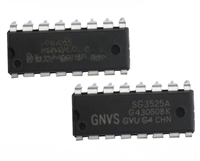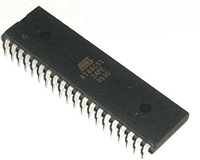AAT3220
150mA NanoPower™ LDO Linear Regulator
The total output capacitance required can be cal-
culated using the following formula:
Applications Information
To assure the maximum possible performance is
obtained from the AAT3220, please refer to the fol-
lowing application recommendations.
∆I
∆V
COUT
=
× 15µF
Where:
Input Capacitor
∆I = maximum step in output current
Typically a 1µF or larger capacitor is recommended
for CIN in most applications. A CIN capacitor is not
required for basic LDO regulator operation.
However, if the AAT3220 is physically located any
distance more than a centimeter or two from the
input power source, a CIN capacitor will be needed
for stable operation. CIN should be located as close
to the device VIN pin as practically possible. CIN val-
ues greater than 1µF will offer superior input line
transient response and will assist in maximizing the
highest possible power supply ripple rejection.
∆V = maximum excursion in voltage that the load
can tolerate
Note that use of this equation results in capacitor
values approximately two to four times the typical
value needed for an AAT3220 at room temperature.
The increased capacitor value is recommended if
tight output tolerances must be maintained over
extreme operating conditions and maximum opera-
tional temperature excursions. If tantalum or alu-
minum electrolytic capacitors are used, the capaci-
tor value should be increased to compensate for the
substantial ESR inherent to these capacitor types.
Ceramic, tantalum or aluminum electrolytic capaci-
tors may be selected for CIN. There is no specific
capacitor ESR requirement for CIN. For 150mA
LDO regulator output operation, ceramic capacitors
are recommended for CIN due to their inherent
capability over tantalum capacitors to withstand
input current surges from low impedance sources
such as batteries in portable devices.
Capacitor Characteristics
Ceramic composition capacitors are highly recom-
mended over all other types of capacitors for use
with the AAT3220. Ceramic capacitors offer many
advantages over their tantalum and aluminum elec-
trolytic counterparts. A ceramic capacitor typically
has very low ESR, is lower cost, has a smaller PCB
footprint and is non-polarized. Line and load tran-
sient response of the LDO regulator is improved by
using low ESR ceramic capacitors. Since ceramic
capacitors are non-polarized, they are less prone
to damage if connected incorrectly.
Output Capacitor
For proper load voltage regulation and operational
stability, a capacitor is required between pins VOUT
and GND. The COUT capacitor connection to the
LDO regulator ground pin should be made as direct
as practically possible for maximum device per-
formance. The AAT3220 has been specifically
designed to function with very low ESR ceramic
capacitors. Although the device is intended to oper-
ate with low ESR capacitors, it is stable over a very
wide range of capacitor ESR, thus it will also work
with some higher ESR tantalum or aluminum elec-
trolytic capacitors. However, for best performance,
ceramic capacitors are recommended.
Equivalent Series Resistance (ESR): ESR is a
very important characteristic to consider when
selecting a capacitor. ESR is the internal series
resistance associated with a capacitor, which
includes lead resistance, internal connections,
capacitor size and area, material composition and
ambient temperature. Typically capacitor ESR is
measured in milliohms for ceramic capacitors and
can range to more than several ohms for tantalum
or aluminum electrolytic capacitors.
The value of COUT typically ranges from 0.47µF to
10µF, however 1µF is sufficient for most operating
conditions.
Ceramic Capacitor Materials: Ceramic capacitors
less than 0.1µF are typically made from NPO or
COG materials. NPO and COG materials are typi-
cally tight tolerance and very stable over tempera-
ture. Larger capacitor values are typically composed
of X7R, X5R, Z5U or Y5V dielectric materials. Large
If large output current steps are required by an
application, then an increased value for COUT
should be considered. The amount of capacitance
needed can be calculated from the step size of the
change in the output load current expected and the
voltage excursion that the load can tolerate.
3220.2001.09.1.0
9







 SG3525资料手册详解:SG3525参数分析、引脚说明、应用介绍
SG3525资料手册详解:SG3525参数分析、引脚说明、应用介绍

 AT89C51单片机资料手册详细解析及应用示例
AT89C51单片机资料手册详细解析及应用示例

 CP2102资料手册解读:CP2102引脚说明、关键参数分析
CP2102资料手册解读:CP2102引脚说明、关键参数分析

 资料手册解读:UC3842参数和管脚说明
资料手册解读:UC3842参数和管脚说明
